|
|
|
Sort Order |
|
|
|
Items / Page
|
|
|
|
|
|
|
| Srl | Item |
| 1 |
ID:
128456
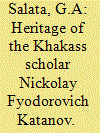

|
|
|
|
|
| Publication |
2013.
|
| Summary/Abstract |
Over 150 years have passed since the birth of one of the most talented, productive and brightest researchers of two past centuries. It has become usual that when they talk about the study of Siberia, particularly of Khakassia, first of all they begin to talk about a meaning - path-breaking. Researches in the sphere of humanities are not an exception. In a famed cohort of Russian pioneering orientalists, one of the first places belongs to outstanding Russian scholar-Turcologist, pedagogue Nickolay Fyodorovich Katanov.
|
|
|
|
|
|
|
|
|
|
|
|
|
|
|
|
| 2 |
ID:
128495
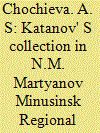

|
|
|
|
|
| Publication |
2013.
|
| Summary/Abstract |
Twelve files, which include the correspondence between N. F. Katanov and N. M. Martyanov, are kept in the archive of Minusinsk Regional museum of local lore'. They give an opportunity to evaluate the contribution of N. F. Katanov to the development of the museum and his interest in his homeland. N. F. KatanOv's letter of 24 January 1894 from Saint Petersburg concerning decoding of Orhon and Yenisei Old Turkic inscriptions is highly characteristic: "Herewith I send my book of script for the museum. Be glad and let all Siberia be glad! In December 1893 Danish researcher W. Thomson and our researcher V. V. Radloff found the most correct key for reading Runic inscriptions. Radloff grew young for 30 years. The script is original, phonetic. About six months ago, Radloff had only guessed and now at the direction of Thomson (with whom he corresponded) and underhis new considerations he learnt to read absolutely fluently. One inscription dates from 738 AD and testifies about Chinese trade with the Arabs and Siberia. . .''.Z
|
|
|
|
|
|
|
|
|
|
|
|
|
|
|
|
| 3 |
ID:
128492
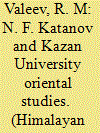

|
|
|
|
|
| Publication |
2013.
|
| Summary/Abstract |
This paper gives an appraisal of Katanov, one of the outstanding founders of Kazan University School of orientalism in the second half of nineteenth and early twentieth centuries. Professor N. F. Katanov is one of the bright and ?amboyant national scholar-thinkers, outstanding representatives of Russian science, education and culture. His life journey and activity reflected important events and tendencies of indigenous and oriental studies. N. F. Katanov's multifarious scientific and pedagogic activity is an unquestionable evidence of great achievements of indigenous orientalism at the turn of nineteenth-twentieth centuries. And his contribution to the development of Kazan oriental studies in this period is indeed invaluable. Since his studentship in Petersburg (1884-1888), his expedition to Southern Siberia and Eastern Turkestan (1889-1892) and tutorage in Kazan (1894-1922), N. F. Katanov's orientalistic activity is connected with complex research of languages, ethnography, folklore and generally spiritual life of the Turkic peoples in Sayan-Altai, Xinjiang, Volga region and Transurals. He had great in?uence on the development of indigenous Turcology in this period.
|
|
|
|
|
|
|
|
|
|
|
|
|
|
|
|
| 4 |
ID:
128471
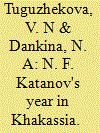

|
|
|
|
|
| Publication |
2013.
|
| Summary/Abstract |
This article is devoted to the description and analysis of scientific events held in Khakassia in connection with the celebration of 150"' birth anniversary of the Khakass scholar, Turkologist, orientalist, Doctor of comparative philology Nickolay Fyodorovich Katanov: an international scientific conference, popularizing the scholar's heritage, collecting and publishing his works. According to the Government decree of the Republic of Khakassia, the year 2012 was declared as Khakass scholar Nickolay Fyodorovich Katanov's Year in Khakassia. In thirteen countries more, which are members of international organization of Turkic culture, the year 2012 was declared as outstanding orientalist, Turkologist N. F. Katanov's Year.
|
|
|
|
|
|
|
|
|
|
|
|
|
|
|
|
| 5 |
ID:
128484
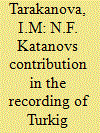

|
|
|
|
|
| Publication |
2013.
|
| Summary/Abstract |
Today the recording of languages is considered to be comparatively a new branch of linguistics, which is connected with field linguistics, i.e. with the study of languages in their natural habitation sphere. N. F.
Katanov may be rightfully named as a field scholar, who professionally approached the recording of languages. The main goal of recording is gathering and accumulation of primary data about poorly explored languages. It is especially now because their number is declining. As A. V. Arhipov notes, activity of a field linguist is aimed at description of 11 language, at direct study of the language phenomena, while various concrete research problems can be resolved. The goal of recording is to gather basic data, which would help to investigate a language hereafter (i.e. to resolve concrete research problems) even if it is impossible to get new data. Texts of different speech genres are fixed (stories, fairy-tales, legends, cases from life, etc.). N. F. Katanov may, therefore, be rightfully named as a true field linguist.
|
|
|
|
|
|
|
|
|
|
|
|
|
|
|
|
| 6 |
ID:
128470
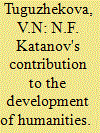

|
|
|
|
|
| Publication |
2013.
|
| Summary/Abstract |
Professor N. F. Katanov has been one of the famous and outstanding national scholars and thinkers of Russian science, education and culture at .the turn of nineteenth and early twentieth century} Scientific and
pedagogic activity of N. F. Katanov is multidimensional. Famous Russian Turkologist G. I. Iskhakov wrote: "Turkologist-orientalists O. N. Blhtlingk, M. A. CastrEn, V. V. Radloff, I. N. Berezin and others_laid the foundation of oriental studies in Russia, then Professor N. F. Katanov enriched this science with new data in the sphere of linguistics, history, archaeology and ethnography through his self-sacrificing work, scrupulous I investigation and long-term research of a language and oriental peoples' ' culture. And, therefore, he got into the line of biggest world scholars"? In oriental studies N. F. Katanov is famous as a scholar encyclopedist having wide interests - language, literature, folklore, history, archaeology, ethnography, numismatology, museology. His scientific interest was not only in history and culture of the Turkic-speaking peoples but also in the Slavonic, Ugro-Finnic, Chinese, Japanese, Arabic, Persian, Indian peoples. He could speak almost all the European languages, many oriental languages, knew also petrified and dead classic languages, read Turkic runes, Sumerian wedge writing, Egyptian and Chinese hieroglyphs, Sanskrit writing, Arabic ligatured script, Old Uyghur and Aramaic ' graphics ?uently". N. F. Katanov's biographers report that he used the data of 114 world languages in his works.'
|
|
|
|
|
|
|
|
|
|
|
|
|
|
|
|
| 7 |
ID:
128489
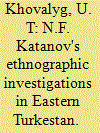

|
|
|
|
|
| Publication |
2013.
|
| Summary/Abstract |
By order of Russian Geographic Society and Russian Academy of Science, 'N. F. Katanov was preparing for the ethnographic and linguistic investigations in South Siberia, Kazakhstan and Eastern Turkestan. In December 1888 he visited a key region of the Yenisei, Uryankhai region for his research of the Tuvinians' (the Uryankhais and Soyons') language and culture, where he stayed till autumn of 1889. From there he went to the regions of rivers Agul, Biryusa and Uda to the Karagas people. There he had been working till April 1890. Later, the texts collected there were publishedl. From the Karagas people N. F. Katanov continued his travel to Semirechye, then in summer 1890 through Chuguchak to Urumchi, to the residency of a governor of Eastern Turkestan. He spent his winter and the beginning of 1891 in Tarbagatai, where having received emperor's letter from Beijing he started to travel around Gansu-Xinjiang again and got to Myao-orl-du (High monastery) which was situated a little bit more eastern from Komul. In March 1892 he hit the road from Komul to Turfan, from where he went through Urumchi, Gulja and through Semirechye again to Minusinsk from where he returned to Saint~Petersburg in December 1892. In Semirechye and Tarbagatai, Katanov researched the language and customs of the Kazakhs from kins kerei, argyn, naiman and Sarat citizens and in Chinese Turkestan he studied the language and traditions of the local Uygursz. In Germany there is some part of ethnographic and linguistic material which was collected by professor N. F. Katanov from the population of north-eastern part of Eastern Turkestan, whidi was famous in the written sources before as Uiguristan (country of the Uygurs).
|
|
|
|
|
|
|
|
|
|
|
|
|
|
|
|
| 8 |
ID:
128482
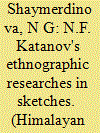

|
|
|
|
|
| Publication |
2013.
|
| Summary/Abstract |
Nickolay Fyodorovich Katanov is one of the outstanding scholar- Turcologists, a researcher of Ural-Altaic world. His creative work was devoted to multidimensional aspects of scientific activity: ethnography and history, linguistics and translation studies, literary studies and folklore, numismatics and museum work, archaeology and local lore. He was also a talented professor whose lectures drew numerous audience at Kazan University. In spite of the multidimensionality of N. F. Katanov's creative activity one of his main merits is the study and research of culture and ethnic world of the Turkic peoples in South Siberia, Eastern Turkestan and Central Asia. Katanov's collection during four years of his travels (1889-1892) of priceless material such as manuscripts and journal records testifies about it. Later these were published in Sketches of Uryzmkhai land.
|
|
|
|
|
|
|
|
|
|
|
|
|
|
|
|
| 9 |
ID:
128485
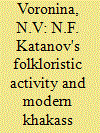

|
|
|
|
|
| Publication |
2013.
|
| Summary/Abstract |
N.F. Katanov's difficult, arduous folkloristic collection is of special value in literary studies and cognitive aspects in his extensive scienti?c, pedagogic, enlightening and social activity. Recorded and processed by an outstanding Khakass scholar, folklore texts are not only keepers and translators of the Turkic peoples' spiritual culture but they also accumulate creative work of Khakass poets and novelists. For example V. K. Tatarova (1952), a Khakass poet and novelist, distinguished public figure and famous theorist of Katanov studies wrote parables/ book of poems Cowberry on a palm in 1995 on the basis of materials of an ethnographic expedition around the Minusinsk depression carried out by N. F. Katanov in 1889-1892. It should be noted that "... in the sphere of the Turkic-speaking habitation of Siberia and Eastern Turkestan a researcher managed to collect a great linguistic, ethnographic and folklore material" which today is of
cognitive value as a collection of Turkic fairytales, fables, songs, proverbs and sayings. "Folklore materials were published in the IX volume of Folk literature samples of the Turkic tribes (St. Petersburgh, 1907) where folklore pieces of work of the Uryankhais (1,410 names), Khakasses (1,159 names), Karagases (203 names) were included"?
|
|
|
|
|
|
|
|
|
|
|
|
|
|
|
|
| 10 |
ID:
128488


|
|
|
|
|
| Publication |
2013.
|
| Summary/Abstract |
Actual position of the investigation of this territory was expressed in academician V. V. Radloff's words: "Importance of the investigation of the Turkic tribes' remains in the far east is unquestionable because these
countries have never been visited by experts of the Turkic languages. And we have only odd bits of information collected by outside observers who were not specially prepared for aimobjective".' In 1891 N. F. Katanov was sent by Imperial Saint-Petersburg Academy of Science and Imperial Russian Geographic Society to Eastern Turkestan as the most prepared specialist in the Turkic languages. The investigation of the territory was held in the framework of an investigation project of the Turkic tribes in Eastern Siberia, Mongolia and Northern China to analyse the Turkic tribes' language and household activities. At that time Eastern Turkestan or Uigurstan was a part of China as its northern region - Xinjiang which included Kashgaria (southern part) and Dzungaria (northern part). Population of this region comprised of different Turkic groups: the Turcomen- Uygurs and Kazakhs-Kirghiz worshiping Islam, the Mongolians-Oirats and Chinese Turcomen worshiping Buddhism, etc.
|
|
|
|
|
|
|
|
|
|
|
|
|
|
|
|
| 11 |
ID:
128453
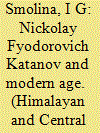

|
|
|
|
|
| Publication |
2013.
|
| Summary/Abstract |
The year 2012 marked the celebration of the 150th birth anniversary of outstanding Russian scholar, orientalist, turkologist, doctor of comparative philosophy Nickolay Fyodorovich Katanov. One may admit that in Khakassia during the recent 150 years a researcher of such high level as Nickolay Fyodorovich Katanov has not been born yet.
|
|
|
|
|
|
|
|
|
|
|
|
|
|
|
|
| 12 |
ID:
128490
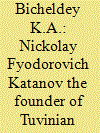

|
|
|
|
|
| Publication |
2013.
|
| Summary/Abstract |
Tuvinian studies is a comparatively new branch in Russian science and represents a set of scientific actions of collective and individual character. In a broader meaning it is a knowledge system about Tuva and the
Tuvinians. Its formation, further development and expansion are connected with the activity of Imperial Russian Geographic Society (IRGS) in the investigation and study of Central Asia in the second half of nineteenth and early twentieth century. The period from 1842 till 1945 can be conditionally called as "the
golden age" of Tuvinian studies. Undoubtedly it was preceded by a range of Tuvinian studies / researches in sixteenth to nineteenth centuries. In this period of history Russian empire strengthened the spread of its
geopolitical interests in Central Asia. Independent explorers and entire expeditions from Russia went to Mongolia, China and Tibet for different purposes including scientific ones. Frequently their pathway ran through the Uryankhai region (one of the former names of Tuva at that time), so explorers and researchers included Uryankhai (Tuva) in the plans of their investigations. Eventually general interest of the Russian empire and its scientific society in Central Asia led to the execution also of special investigations about Tuva.
|
|
|
|
|
|
|
|
|
|
|
|
|
|
|
|
| 13 |
ID:
128487
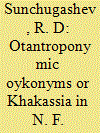

|
|
|
|
|
| Publication |
2013.
|
| Summary/Abstract |
In recent years in linguistics, investigation of proper names including anthroponymics and oykonymics has been developing extensively. Anthroponymics is a branch of onomastics, which studies anthroponyms
-personal names of people: proper names, patronymics (father's names or other names after father), surnames, tribal names, nicknames and pseudonyms (individual or group), cryptonyms (concealing names)';
oykonymics is a branch of toponymy, which studies oykonymsz, i.e. names of any settlements. These branches are still one of the poorly studied ?eld of Turkic onomastics. In Khakass toponymy considerable part of settlements' names belong to anthroponyms, i.e. proper names and surnames. Formed from anthroponyms, oykonyms give important information of linguistic, historical, ethnographical and ethnocultural nature. They point at the bygone settlement of peoples and tribes, reflect traditional folk culture
and change processes in the socio-political and economic life of people.
|
|
|
|
|
|
|
|
|
|
|
|
|
|
|
|
| 14 |
ID:
128483
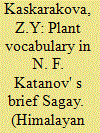

|
|
|
|
|
| Publication |
2013.
|
| Summary/Abstract |
Nickolay Fyodorovich Katanov was a great scholar, who gathered the richest material in ethnography, linguistics and folklore, providing a valuable source for studying different sides of the Turkic peoples' life, including Khakasses. Being a linguist- Turcologist N. F. Katanov started his scientific work with the study of the Khakass language, which he spoke, and relying on its knowledge, he began to research other related kind red languages. During his study in Krasnoyarsk high school, he went to various places every year, gathered folklore, linguistic texts and described the customs of the Sagay people. A researcher of the Tatar language D. G. Tumasheva notes: "Nicloloy Fyodorovich was not only an educated and intelligent man but he had his own material, which had been written by him from the first hand through direct contact with the people. N. F. Katanov laid emphasis on the latter, considering the necessity to study a language by means of direct interaction with the people and not by separating history of a language from ethnography, folklore and history of material culture."
|
|
|
|
|
|
|
|
|
|
|
|
|
|
|
|
| 15 |
ID:
128472


|
|
|
|
|
| Publication |
2013.
|
| Summary/Abstract |
One of the most unexplored aspects of N. F. Katanov's life is his social activity. Researchers distinguish several directions of N. F. Katanov's social activity: activity in scienti?c societies, museum and literature work, lectures, translation, editing and publishing activity. A researcher of the Tatarstan Republic National archives G. A. Dvoenosova, having conducted a study on Kazan ecclesiastical academy fund, where N. F. Katanov worked from 1911, notes that he was a member of 9 scientific societies: Imperial Russian archaeological society (since 30 March 1884 - a member-officer, since 10 March 1898 - an actual member), . .iperia1 Russian geographical society (since 17 December 1894 - an actual member), Imperial Society of natural science, anthropology and ethnography (since 22 November 1897 - an actual member), Society of archaeology, history and ethnography attached to Kazan University (since 18 March 1898 - chairman, since 22 February 1909 - an honorary member), International society of sciences and literatures in Leuven (Belgium) (since 14 February 1898 - an ordinary member); Hungarian ethnographical Society in Budapest (since 17 March 1899 - a foreign member), Helsingfors Finno-Ugric (since 20 November 1900 - an actual member)'
|
|
|
|
|
|
|
|
|
|
|
|
|
|
|
|
| 16 |
ID:
128486


|
|
|
|
|
| Publication |
2013.
|
| Summary/Abstract |
The first information about the Khakass dialects and their phonetics is contained in pre-revolutionary sources, first of all in the works of M. A. Castren, V.V. Radloff, N. F. Katanov. In his work Versuch einer koibalischerz und karagassischerz Sprczchlehrel M. A. Castren described the Koybal dialect of the Khakass language; in the section Phonetics, he details the composition of vowels and consonants of the dialect. Next researcher in the phonetics of the Khakass dialects is V. V. Radloffz. It is for the first time in the history of Tu rcology, that he represented the entire classification of sound structure of the Turkic languages-'. I_ However, one of the most famous representatives of pre-October h Khakass studies is N. F. Katanov.
|
|
|
|
|
|
|
|
|
|
|
|
|
|
|
|
| 17 |
ID:
128480
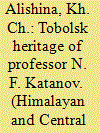

|
|
|
|
|
| Publication |
2013.
|
| Summary/Abstract |
Scholars of the Tyumen region systematically refer to the scientific heritage of unique scholar-Turcologist Nickolay Fyodorovich Katanov. After his successful graduation from oriental department of Saint Petersburg University in 1889, N. F. Katanov was sent to a long field trip by the Imperial Russian Geographic Society and Petersburg Academy of Science ' to Siberia, Northern Mongolia, Dzungaria and Chinese Turkestan. Here n he studied customs, household activities, language and folklore of the local Turkic peoples besides collecting, processing and preparing huge material for publication. Outstanding orientalist N. F. Katanov enriched indigenous Turcology with extraordinary scientific works concerning the Siberian Tatars. Katanov carried out labour-intensive work in defining and systematizing all proper names that led to the release of two-volume alphabetical index of names which appear in Folk literature samples of the Turkic tribes of V. V.
Radloff. The lion's share of these materials is data on onomastics of the Siberian Tatars.
|
|
|
|
|
|
|
|
|
|
|
|
|
|
|
|
| 18 |
ID:
128499


|
|
|
|
|
| Publication |
2013.
|
| Summary/Abstract |
According to S. E. Malov's division of the Turkic languages, the Khakass language is old. It preserved Old Turkic roots in unchanged form and includes those which led to the development of verbal forms. That is why the study of Khakass lexis and especially verbal lexis is of apparent interest for a Turcologist. In this work there is the analysis of Khakass verbal lexis of the late 19th century contained in a comparative framework with material of the modern Khakass language. The first part of N. F. Katanov's work The Tatar language (the Sagay dialect) includes grammar (etymology and syntax). The second part is devoted to a corpus of examples and Sagay-Russian dictionary. This work contains more than 800 Copybook sheets. N ickolay Fyodorovich was preparing it during his study at Krasnoyarsk classic high school. He finished it in 1884. The work is still unpublished. It is invaluable for the dialectology and history of the Khakass language.
|
|
|
|
|
|
|
|
|
|
|
|
|
|
|
|
|
|
|
|
|